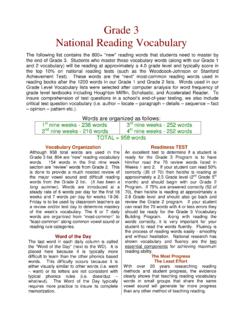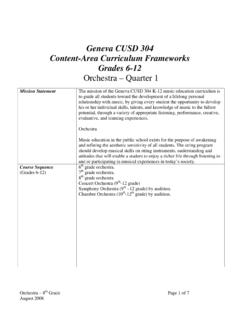Transcription of 6 + 1 Traits of Writing - Geneva 304
1 6 + 1 Traits of Writing Acronym Voice Ideas Presentation Conventions Organization Word Choice Sentence Fluency 1 What is the Six plus One Traits of Writing ? The Six plus one Trait is a way of teaching, modeling, and assessing the instruction of Writing . The Six Traits of Writing are Voice, Ideas, Presentation, Conventions, Organization, Word Choice, and Sentence Fluency. It creates a common vocabulary and guidelines for teachers to use with students so that they become familiar with the terms used in Writing . It develops consistency from grade level to grade level. The Six Traits model allows teachers and students to focus on one or two elements of Writing at a time creating a more manageable and effective way for students to learn how to write. It also is a means of providing specific feedback to students through the assessment of their Writing . The Six Traits help both the student and teacher identify the areas of Writing that the student needs work at improving.
2 Good Writing must incorporate the Six Traits . The Plus One trait is the presentation of the Writing piece. This is the trait that is considered for all Writing , but not specifically or directly taught as the other Traits are. 2 Types of Writing Narrative: A narrative tells a story. It has a beginning, middle and an ending. Expository: An expository gives facts, explains ideas, directions or terms. Persuasive: A persuasive Writing piece tries to convince the reader to support an opinion. The Writing Process Prewriting: The student brainstorms and thinks about what to write. Drafting: The student writes down their thoughts on paper. It is the rough draft or sloppy copy. Revising: The student rereads their work and makes changes to make the Writing piece better. Proofreading: The student edits the paper for conventions. Publishing: The student writes the final copy. It is ready to be shared with others.
3 3 Ideas are the content of the Writing piece. They are the heart and soul of good Writing . It is important for students to remain focused on the Writing by selecting the idea or topic, remaining focused on the idea, elaborating on the idea, and using details and information to further develop the piece of Writing . Ideas enable students to move from a general to more specific Writing . The following are guidelines for the Idea trait: 1. The topic is narrow, clear and manageable. 2. The supporting details provide information that goes beyond the obvious. 3. The supporting details are accurate and support the main idea. 4. The writer knows what he/she is Writing about. The Writing shows knowledge or experience about the idea. 5. The writer provides information that is important. 6. The reader understands what the writer is trying to convey and can often visualize the information. Writing Activities for Children to focus on the Ideas Trait: Give students an object (rock, greeting card, etc.)
4 To focus on Writing about. Have child pay close attention to the detail and describe the detail in Writing . Ask the student to write about a thing that they love. This may be a favorite vacation, a hobby, an animal etc. Children love to write about things that interest them. 4 Read a story that contains and elaborates on good ideas. Discuss how the author writes so that the reader can visualize what is happening in the story. Have the student write about an event in their life, then have someone else listen to the piece of Writing and draw a picture of what they visualize based on what they have heard. Have the student write and use the Ideas Checklist to analyze the strengths and weaknesses of their Writing on a one-to-one basis. Recommended Books for the Idea Trait: Miss Nelson is Back, by James Marshall and Harry Allard Frog and Toad, by Arnold Lobel Magic School Bus at the Water Works, by Joanna Cole George and Martha, by James Marshall Roxaboxen, by Alice McLerran Where the Wild Things Are, by Maurice Sendak Something Beautiful, Sharon Dennis Wyeth Rotten Teeth, by Laura Simms Eeny, Meeny, Miney Mole, by Jane Yolen 5 Ideas Checklist for Writing Focus-ISAT Ideas-Six Traits Has clear main message expressed with multiple detailed sentences Creates Writing that can be read by another reader Uses multiple sentences to enrich ideas or extend stories May revise by adding details Creates Writing that explains, gives directions, tells a story and/or describes Name: _____ Number of checks.
5 _____ Focus-ISAT Ideas-Six Traits Has clear main message expressed with multiple detailed sentences Creates Writing that can be read by another reader Uses multiple sentences to enrich ideas or extend stories May revise by adding details Creates Writing that explains, gives directions, tells a story and/or describes Name: _____ Number of checks: _____ Focus-ISAT Ideas-Six Traits Has clear main message expressed with multiple detailed sentences Creates Writing that can be read by another reader Uses multiple sentences to enrich ideas or extend stories May revise by adding details Creates Writing that explains, gives directions, tells a story and/or describes Name: _____ Number of checks: _____ Focus-ISAT Ideas-Six Traits Has clear main message expressed with multiple detailed sentences Creates Writing that can be read by another reader Uses multiple sentences to enrich ideas or extend stories May revise by adding details Creates Writing that explains, gives directions, tells a story and/or describes Name: _____ Number of checks: _____ 6 Once the idea or topic is narrowed, the student can begin the organization of the Writing piece.
6 Organization is the structure of the Writing piece and how it is presented. It holds the information together and can be easily comprehended by the reader. Structure may be based on comparison and contrast, deductive logic, theme based, events explained in chronological order, or fact based. Writing can be in the form of an expository, narrative, or persuasive essay, a paragraph, a poster, a brochure, or any other form of Writing . All Writing must be presented in an organized manner in order for the Writing to be effective and meaningful. The following are guidelines for the Organization trait: 1. Before Writing , think about how the Writing should be structured to be the most effective. Is there a pattern that can be used that would be the most successful in relaying the purpose of the Writing ? (Compare/contrast, sequencing etc.) 2. Choose an introduction that is an attention grabber. The reader must be interested in reading on.
7 3. Use transitions within the Writing that connects the ideas together and allows for the paper to flow. 74. Use details where they are appropriate and needed. Sequencing must be logical in order for it to be effective. 5. The Writing piece shows that the organization flows and the reader is engaged in the reading. 6. The conclusion leaves the reader with resolution. Writing Activities for Children to focus on the Organization Trait: Hand out six index cards. Choose and activity such as brushing your teeth. Have the student write down the step-by-step procedure for the activity they choose. Mix the index cards and have another person put the cards in the order that the activity should take place. Discus how the importance of Writing events in logical order gives the reader a clear picture of the purpose of the Writing . Use a Web to plan ideas before Writing . Read a book from the recommended list.
8 Discuss how the structure of the Writing is developed and why the organization was important. What happened if the story wasn t organized? Would you understand it? What meaning would you have gotten from it? Have the student write a How To paper and use the Organization Checklist to analyze the strengths and weaknesses of their Writing on a one-to-one basis. How To papers may be about making a peanut butter sandwich, eating and Oreo cookie, etc. Look at a wordless picture book, (for example : Snowman, by Raymond Briggs), have the student look at the pictures and put the story into words following the order that the events took place. Recommended Books for the Organization Trait: Ira Sleeps Over, by Bernard Waber The Mouse and the Motorcycle, by Beverly Clearly Charlottes Web, by White Goldilocks and the Three Bears (any author) Snowman, by Raymond Briggs The Legend of Bluebonnet, by Tomie DePaola The Three Pigs (any author) A House for Hermit Crab by Eric Carle Alexander and the Terrible, Horrible, No Good, Very Bad Day.
9 Rotten Ralph by Jack Gantos. 8 Organization Checklist For Writing Organization ISAT Organization-Six Traits Writes multiple sentences that show development or sequencing. Stays focused on the topic. Follows a logical order. Uses transition words within Writing . Writing has a beginning and an ending. Name: _____ Number of checks: _____ Organization ISAT Organization-Six Traits Writes multiple sentences that show development or sequencing. Stays focused on the topic. Follows a logical order. Uses transition words within Writing . Writing has a beginning and an ending. Name: _____ Number of checks: _____ Organization ISAT Organization-Six Traits Writes multiple sentences that show development or sequencing. Stays focused on the topic. Follows a logical order. Uses transition words within Writing . Writing has a beginning and an ending. Name: _____ Number of checks: _____ Organization ISAT Organization-Six Traits Writes multiple sentences that show development or sequencing.
10 Stays focused on the topic. Follows a logical order. Uses transition words within Writing . Writing has a beginning and an ending. Name: _____ Number of checks: _____ 9 Word choice involves using the right words in Writing that will give clarity, evoke feelings, moods, likes and dislikes, and creates a vivid picture in the readers mind. Students become aware that there are different ways to express their thoughts. They become more aware of the use and power of language by adding new and varied words within their Writing . Using vivid, colorful and dynamic words will expand and enrich student Writing . The following are guidelines for the Word Choice trait: 1. The words are specific to where the reader understands what the writer means. 2. Words and phrases are used to maintain the readers attention. The reader is anxious to read on. 3. The selection of words should include new words, words that show action or movement, words that describe, words that go beyond the child s spelling ability, words that help the reader see, feel, hear, taste, or understand.



